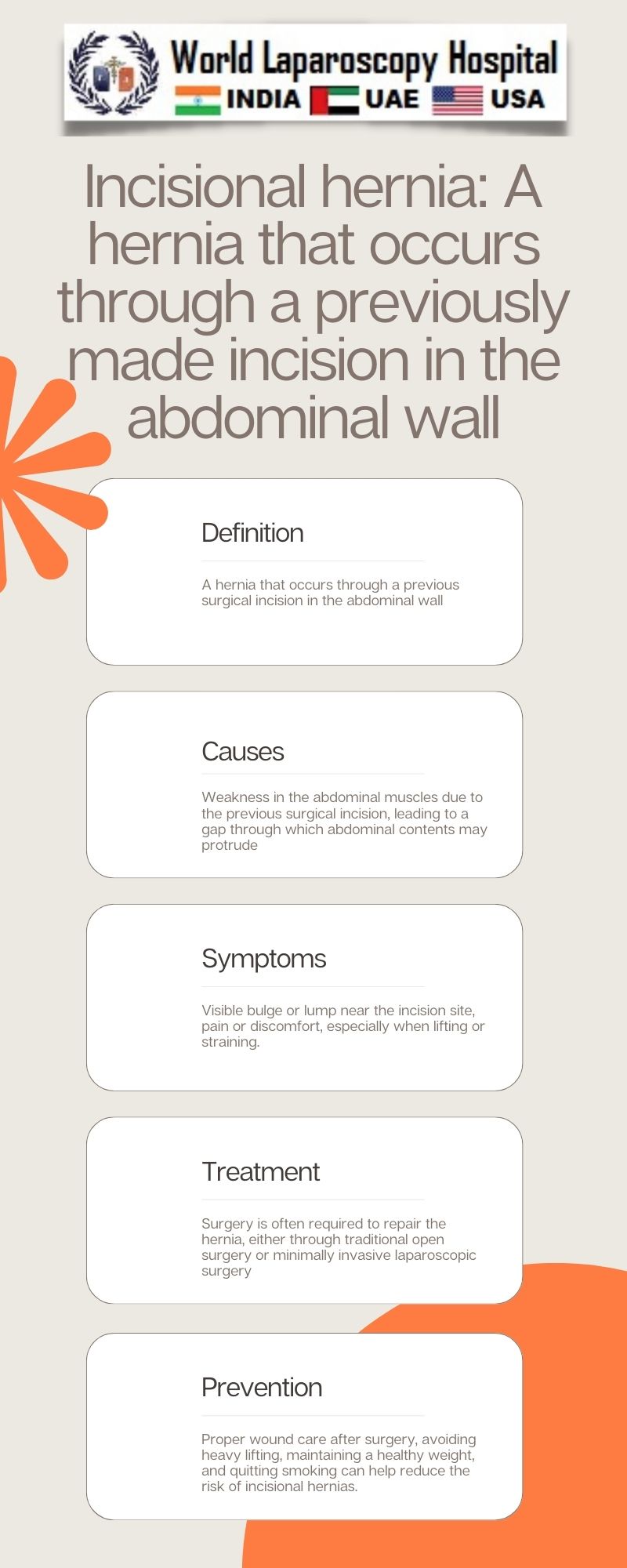Introduction
An incisional hernia is a type of hernia that occurs at the site of a previous surgical incision in the abdominal wall. It happens when the internal tissues or organs protrude through the weakened area of the abdominal wall, creating a bulge or lump. This condition can be painful and may require medical intervention. Understanding the causes, symptoms, diagnosis, treatment, and prevention of incisional hernias is crucial for managing this condition effectively.

Causes of Incisional Hernia
Incisional hernias develop due to the weakening of the abdominal wall, which can be caused by various factors, including:
Poor surgical technique:
Improper closure of the incision after surgery can lead to weakness in the abdominal wall.
Increased abdominal pressure:
Activities that increase intra-abdominal pressure, such as heavy lifting, coughing, or straining during bowel movements, can strain the weakened area and cause a hernia to develop.
Obesity:
Excess body weight can put additional pressure on the abdominal wall, increasing the risk of herniation.
Smoking:
Smoking can impair the healing process, increasing the likelihood of hernia formation after surgery.
Chronic cough:
Conditions such as chronic obstructive pulmonary disease (COPD) that cause frequent coughing can strain the abdominal wall and contribute to hernia development.
Symptoms of Incisional Hernia
The primary symptom of an incisional hernia is a visible bulge or lump at the site of the surgical incision. Other symptoms may include:
Pain or discomfort:
Especially when lifting objects or straining.
Swelling:
Around the hernia site.
Bowel obstruction:
If the herniated tissue becomes trapped and blocks the intestines.
Nausea and vomiting:
If bowel obstruction occurs.
Diagnosis of Incisional Hernia
A healthcare provider can diagnose an incisional hernia through a physical examination. Imaging tests, such as ultrasound, CT scan, or MRI, may be used to confirm the diagnosis and assess the size and extent of the hernia.
Treatment of Incisional Hernia
Treatment options for incisional hernias depend on the size and severity of the hernia, as well as the patient's overall health. Some common treatment approaches include:
Watchful waiting:
Small, asymptomatic hernias may not require immediate treatment but should be monitored regularly.
Hernia belt or truss:
Wearing a supportive garment may help reduce discomfort and prevent the hernia from enlarging.
Surgical repair:
Most incisional hernias require surgical intervention to repair the weakened abdominal wall. The surgeon may use traditional open surgery or minimally invasive laparoscopic techniques.
Hernia mesh:
In many cases, the surgeon will reinforce the repaired abdominal wall with a synthetic mesh to reduce the risk of hernia recurrence.
Prevention of Incisional Hernia
While not all incisional hernias can be prevented, there are steps that can be taken to reduce the risk:
Maintain a healthy weight:
Obesity is a significant risk factor for hernia development. Maintaining a healthy weight through diet and exercise can help reduce this risk.
Quit smoking:
Smoking can impair the healing process and increase the risk of hernia formation. Quitting smoking can reduce this risk.
Follow postoperative instructions:
Proper wound care and following your surgeon's instructions for activity levels and lifting restrictions can help prevent hernias after surgery.
Avoid heavy lifting:
Straining the abdominal muscles can increase the risk of hernia formation. Avoid lifting heavy objects if possible, and use proper lifting techniques when necessary.
Conclusion
Incisional hernias are a common complication of abdominal surgery, occurring when internal tissues or organs protrude through a weakened area of the abdominal wall. While not always preventable, understanding the causes, symptoms, diagnosis, treatment, and prevention strategies for incisional hernias can help individuals manage this condition effectively and reduce the risk of complications. If you suspect you have an incisional hernia, it is important to consult with a healthcare provider for proper evaluation and treatment.